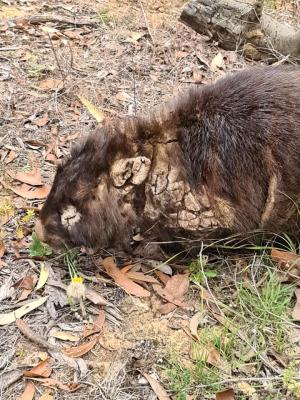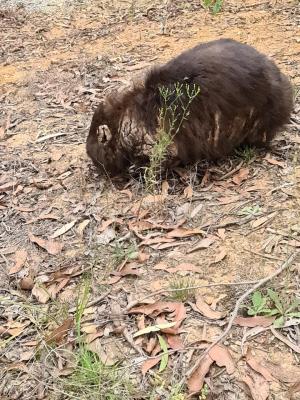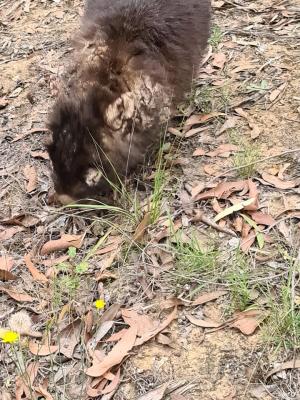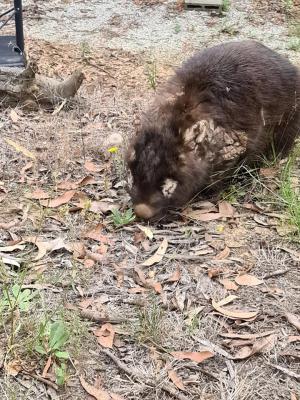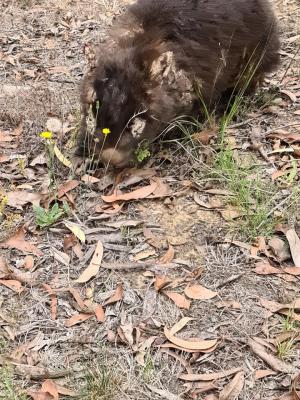By Mikayla Van Loon
When Lyndal Warne first noticed a wombat walking on the back verandah of her 72 acre property, she knew something wasn’t right.
Worried for the health of her three dogs, Ms Warne took to the Gembrook community noticeboard to get advice.
“This wombat started hanging around the house and the dogs were freaking out a bit, they were very confused and then I realised it was sick, covered in mange. So that’s why I just put it out there because I guess a lot of people think you’ve got to euthanise it if it’s that bad,” Ms Warne said.
Mange is a slow-growing infestation wombats contract, causing them to behave differently like coming out during the day, losing eyesight and hearing, as well as becoming covered in scab-like growths.
It’s a type of mite that burrows itself under layers of skin and lays eggs causing the growths to form on the outside.
Wombats can be known for wandering around in the middle of the day and it doesn’t always mean something is wrong but in some cases it can be a cry for help.
“One of the most common misconceptions with the public is that wombats are only nocturnal and that isn’t quite true, they actually come out during the day and it isn’t a sign of anything wrong, sometimes,” case coordinator and vice president of Mange Management, Jason Simpson said.
Not only does mange affect wombats, humans are also susceptible but in the form of scabies, with foxes being the next most common animal to contract the infestation.
The good thing about mange is there is a treatment for it.
After getting an overwhelming response on her post, Ms Warne got in contact with Manage Management to discuss treatment and picked up a treatment kit from Avonsleigh veterinary clinic.
The wombat on her property has now received one dose and is due to receive another over the weekend.
She’s hoping once the wombat starts feeling better and regains its eyesight, it will head back into its burrow – although Ms Warne is concerned she won’t be able to find it then.
Treatment time varies but usually between six to eight weeks results will occur – the liquid put on the wombat doesn’t stay in the bloodstream long so they only give a low dose once a week.
It is also dependent on the severity of the wombat’s condition and the length of time it has had mange.
“Generally mange takes a long time to progress and it’s common for a wombat to have mange for a year before it gets reported to us and then gets treated, so it’s a slowly progressing condition not always but generally,” Mr Simpson said.
Mr Simpson said mites can not survive on their own in the wild and have to be carried on a host animal but external factors might contribute to their survival.
“There is a lot that we don’t know about why mites do better in some areas than others, so there may be an environmental influence for them doing well,” Mr Simpson said.
The higher density areas where human and wombat populations are more extensive, is usually where the most cases are reported to Mange Management.
The Dandenongs seem to be at the top of that list, with suburbs like Olinda and Emerald reporting cases most frequently.
Mr Simpson estimates that of the 1200 calls in the Mange Management database, one in five is from the Mount Dandenong region.
“Generally people in those areas know about what mange is and know there is something you can do about it, so those good people flood us with reports and we love that,” Mr Simpson said.
Mr Simpson said the best thing to do if a wombat with mange is spotted is to contact Mange Management by calling the hotline on 0431 600 125.
It’s best to be standing in front of the wombat at the time so that Mr Simpson can advise what to do next, as well as assess whether the wombat has any other health concerns.
“It’s one of our ethical responsibilities to properly diagnose a wombat for the most pressing issue that it has, so it’s possible for it to have mange but also have something else that is far more urgent and it would be negligent of us to just treat the mange and ignore the more pressing issue,” Mr Simpson said.
Submitting a location report is also incredibly important as some wombats may already be receiving treatment from someone else in the community which can be done by heading here https://mangemanagement.org.au/report-a-wombat/

